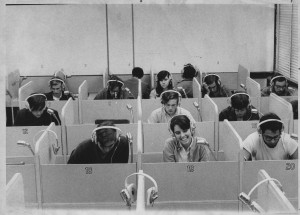The middle of the 20th century was an exciting time for foreign language study in the United States. During World War II, the army created the Army Specialized Training Program (ASTP) to provide education to officers with strategic wartime skills, including foreign language proficiency. Following the scholarly opinion among linguists of the day, who believed that language was acquired through habit, the ASTP taught language primarily through oral drills. As the ASTP spread to institutions of higher education throughout the country, the army developed audio discs in dozens of languages.
The so-called Army Method of language instruction, which relied heavily on oral drills accompanied by recordings, remained popular after the war. At the time, Americans were optimistic that the application of science and technology would revolutionize education. In the summer of 1952 Reed College offered a class in “Oral French.” The course was taught using the Army Method and advertised that classes were “supplemented by laboratory session where students may listen to records and make their own recordings.”
Then, on October 4, 1957, the USSR launched Sputnik.
Within a year, Eisenhower signed into law the National Defense Education Act (NDEA), which was meant to bolster education in critical areas. Title VI of the NDEA provided funding for foreign language instruction, while Title VII provided funding for educational technology. Many colleges and universities used these NDEA funds to create specialized language laboratories. The standard college language lab, created specifically for the drill-based exercises of the Army Method, featured rows of soundproof cubicles, all outfitted with tape recorders and headsets.

Reed College Language Lab, 1967, by Wyn Berry
Courtesy of Special Collections, Reed College Library http://cdm.reed.edu/u?/reedhisttxt,18522
In the following decades, however, the Army Method fell out of favor, and it was no longer clear what role technology had in the teaching of foreign languages. Even with the advent of the digital age in the 1980s, the close connection between language learning and technology that the Army Method required has never reemerged. In the beginning, language labs were dedicated spaces for a very specific piece of technology. A vast array of digital resources related to language learning, accessible on a variety of platforms, is now available. The language lab evolved from a dedicated space for specialized equipment to a clearinghouse of information about online resources and an interactive space for language exploration.
The Language Lab at Reed College is a collaborative environment, where students interested in language come together to learn and explore. Last year, the lab space was redesigned to allow for more interaction. Drop-in tutoring is available in all languages currently offered at Reed. The lab is outfitted with region-free Blu-Ray players, so you can watch foreign movies from the IMC. You can even reserve the language lab and use the projector for a group movie viewing.
Our website offers language-specific resources and recommendations. Are you planning to study abroad, do thesis research overseas, or take a trip in another part of the world? You can find links for language-learning tools like Mango Languages and Duolingo on our website as well.
In contrast to its origin as a place where students sat in individual cubicles to complete rote drills, we hope that you use the language lab as a place to explore and create with like-minded members of the Reed community. We’re always open to new ideas about language exploration. Stop by and see us!
